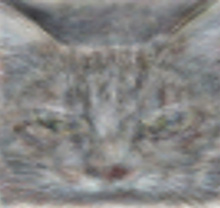Source: “Building High-level Features Using Large Scale Unsupervised Learning”

Quoc Le et al.
International Conference on Machine Learning, Edinburgh, U.K., June 26–July 1, 2012
Results: Researchers at Google developed software, modeled on the way biological neurons interact with each other, that taught itself to distinguish objects in YouTube videos. Although it was most effective at cats and human faces, the system could recognize 3,200 items in all, a 70 percent improvement over the previous best-performing software.
Why it matters: The approach could help image recognition technology identify a much wider range of objects than it can now. That could make image search engines more powerful or help make robots better at interpreting their surroundings.
Methods: Previous image recognition software learned to recognize specific objects by being shown examples labeled by humans, such as a series of images with faces marked. Google’s system doesn’t need labeled examples and can learn from any image, which means the objects it recognizes aren’t limited to a small number of domains in which it has been trained. The software finds patterns in images and sorts them into categories of objects, in part by brute force: 1,000 computers worked together to sort through 10 million images from YouTube, harnessing much more processing power than is typical for image recognition systems.
Next steps: Google has moved the project out of its research division and into the part of the business responsible for search. The new techniques could be used to improve speech recognition, translation, and image search technology.
Speedier Data Storage
Improved phase-change devices could replace all forms of computer memory
Source: “Breaking the Speed Limits of Phase-Change Memory”
Shi Luping et al.
Science 336: 1566–1569
Results: Researchers at the Data Storage Institute of the Agency of Science, Technology, and Research in Singapore and the University of Cambridge, U.K., created a version of phase-change memory that operates an order of magnitude faster than any before, flipping from a digital 0 to a 1 in just 500 picoseconds (500 trillionths of a second). It’s approximately 1,000 times faster than the type of memory it’s meant to replace.
Why it matters: Phase-change memory is a leading candidate to replace the flash memory used in memory cards, mobile devices, and newer laptop computers, because it can store data more densely and at a faster rate. The new speed record suggests it could even be fast enough to take the place of the short-term memory in computers, known as DRAM.
Methods: Phase-change memory represents digital 1s and 0s by using an electric current to flip a metallic alloy between crystalline and disordered forms. Crystal growth is affected by temperature, so the researchers used a weak electric field to preheat the memory cells, enabling them to become crystalline more quickly when necessary. Tests that repeated the process 10,000 times showed that the new approach did not reduce the performance of a phase-change memory cell over time. Although the preheating technique means the memory consumes more energy, the researchers say it doesn’t use much more than a conventional design.
Next steps: The researchers intend to investigate whether changes to the phase-change material or to the way the cells are preheated will deliver even greater speed increases.
Keep Reading
Most Popular
Large language models can do jaw-dropping things. But nobody knows exactly why.
And that's a problem. Figuring it out is one of the biggest scientific puzzles of our time and a crucial step towards controlling more powerful future models.
How scientists traced a mysterious covid case back to six toilets
When wastewater surveillance turns into a hunt for a single infected individual, the ethics get tricky.
The problem with plug-in hybrids? Their drivers.
Plug-in hybrids are often sold as a transition to EVs, but new data from Europe shows we’re still underestimating the emissions they produce.
Stay connected
Get the latest updates from
MIT Technology Review
Discover special offers, top stories, upcoming events, and more.